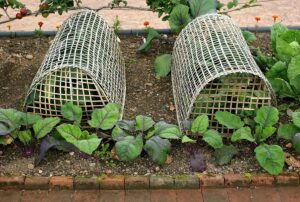 Protect vegetable seedlings planted in the garden from cool and cold nighttime temperatures. Protect warm-season seedlings such as tomatoes and peppers from temperatures below 55°F. Protect cool-season seedlings such as lettuce and cabbage from temperatures below 45°F.
Protect vegetable seedlings planted in the garden from cool and cold nighttime temperatures. Protect warm-season seedlings such as tomatoes and peppers from temperatures below 55°F. Protect cool-season seedlings such as lettuce and cabbage from temperatures below 45°F.
Cages and tunnels covered with plastic are quick ways to protect crops and extend the warmth needed for plant growth.
Wire cages. Use cages–a small or large wire tomato cage will do–to protect tomatoes, peppers, eggplants, and melons. Once a seedling is set out in the garden, put the cage in place around the plant. Next cut the end out of a plastic garbage bag and fit the bag over the cage creating a plastic tube surrounding the seedling. Alternatively, wrap plastic sheeting around the cage and tape it in place. If temperatures really dip, take a second garbage bag and place it over the top of the cage at night creating a mini-greenhouse.
Sections of wire can be used to cover row-crop seedlings or seedlings planted in a bed. Form the wire into hoops and place them in the ground then set plastic sheeting over the hoops forming a tunnel or small hoop-house. Be sure to select wire heavy enough to support the sheeting–12 or 10 gauge wire should do. Plastic sheeting at least 4 or 6 millimeters will keep out the cold. Clear or opaque sheeting will work.
Hoops and tunnels. Hoops and tunnels also can be made with PVC irrigation tubing anchored in the ground. Use at least 5/8-inch tubing and anchor the hoops by securing them in 6-inch sections of 1-inch plastic tubing driven into the ground. Set the plastic sheeting over the top and secure it with soil or boards. When nighttime temperatures begin to warm the plastic can be replaced with light spun-poly row covers and in the summer with bird netting if birds and critters visit your garden.
Note that the temperature inside your plastic tunnel will be 5 to 10 degrees warmer than the outside temperature–or more. On clear warm days, the temperature in a plastic tunnel can heat up quickly. Just as seedlings don’t like cold temperatures, they also do not like temperatures too warm. Don’t let the temperature in your plastic tunnel heat up to more than 80°F.
Here are a few more ways to protect seedlings from cool or cold temperatures:
• Stretch clear plastic across two 12 inch by 1 inch boards set on either side of the seedlings.
• Place a half cylinder of construction wire or chicken wire over the seedlings and stretch plastic sheeting over the top.
• Drive stakes at the corners of the planting bed and stretch plastic or floating rows covers over the top.
• Cut the ends out of a cardboard box and set it over the seedling and cover with plastic.
• Lean two wooden trellises over the crop and place plastic sheeting over the top forming an A-frame tunnel.
For a long-lived plastic tunnel, use rigid plastic sheeting or translucent fiberglass (typically 4 feet wide by 8 feet long). These can be set like an A-frame over plants.















